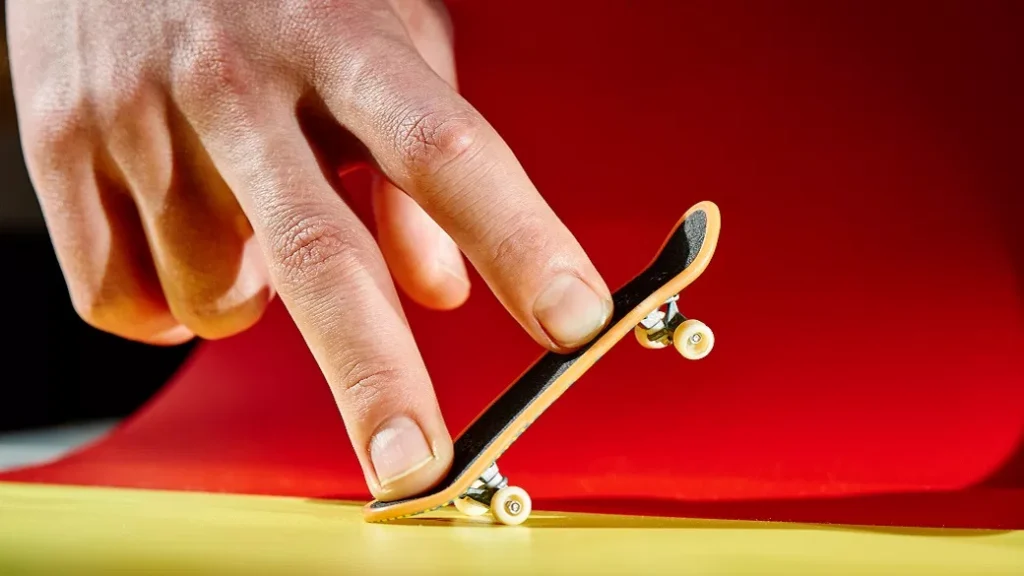Fingerboard culture is blowing up—and no, we’re not talking about full-sized skateboards. These scaled down decks, fair many inches long, are turning work areas and countertops into skateparks for your fingers. Whether you’re flipping over a scratch pad or crushing a stapler, fingerboarding brings fashion, aptitude, and a entirety part of fun in miniature frame.
What Is a Fingerboard?
A fingerboard may be a scaled-down adaptation of a genuine skateboard-usually approximately 96mm long-that you ride utilizing your fingers rather than your feet. Envision Tony Hawk’s moves, but your list and center fingers are doing the overwhelming lifting. It’ more than fair a toy-it’s a legit subculture.
A Quick History
Fingerboards actually date back to the late ’80s when skateboarders made miniature versions to demo tricks or pass time. By the ’90s, Tech Deck popularized mass-produced fingerboards, making them a schoolyard craze.
Fingerboard vs. Tech Deck: Are They the Same?
Not quite. Tech Deck is a brand, while fingerboard is the broader term. Tech Decks are typically mass-produced and affordable, while pro fingerboards can be custom-made with real wood, metal trucks, and urethane wheels.
Why Are Fingerboards So Popular?
A Creative Outlet
Fingerboarding isn’t just about tricks—it’s a canvas for creativity. People design custom decks, build mini skateparks, and even produce fingerboard films. It’s skateboarding meets DIY art.
Portability & Accessibility
You don’t need a ramp or an empty pool—just a desk, a couple of fingers, and some imagination. It’s perfect for indoors, travel, or when your real skateboard is out of commission.
Social Media & Fingerboard Fame
Platforms like TikTok and Instagram have blown up the fingerboard scene. Short videos of insane combos and smooth manuals can rack up millions of views. Some fingerboarders even become influencers in their own right.
Components of a Fingerboard
Believe it or not, these mini boards have real-deal components, just like the ones you ride with your feet.
Deck
Usually made of plastic or wood, the deck is the base of your board. Wooden decks are often favored for their pop and aesthetic appeal.
Trucks
These mini metal pieces allow your board to turn and grind. High-end trucks are made of real metal and come with bushings and pivot cups.
Wheels
From plastic to urethane, wheels vary in smoothness and grip. Urethane is the gold standard—it feels just like the real thing.
Grip Tape
A rough surface on the top of the deck gives your fingers traction, just like grip tape on a full-sized board.
How to Fingerboard: The Basics
So, how do you indeed begin? It may see simple, but fingerboarding incorporates a soak learning curve-and that’s portion of the fun.
Starting With the Ollie
The ollie is your entry ticket to the trick world. Press down on the tail with your back finger, then quickly slide your front finger forward to pop and level the board in the air.
Mastering the Kickflip
Flick the edge with your index finger after the ollie motion, and boom—a kickflip. Well, maybe not boom. More like… splat. Then boom, after a few hundred tries.
Creating Combos
Once you’ve nailed the basics, start stringing them together. Think ollie to grind to manual to flip out. Fingerboarding is like writing poetry—with fingers.
Customizing Your Fingerboard
One of the coolest parts of fingerboarding is making your board uniquely yours.
DIY Builds
Want to glue popsicle sticks into a mini halfpipe? Go for it. Fingerboarders build railings out of paperclips, ramps out of cardboard, and entire skateparks out of wood.
Professional-Grade Setups
Serious about the hobby? There are companies making top-tier components—and they aren’t cheap.
Popular Brands to Check Out
Blackriver – Premium ramps and trucks
FlatFace – Urethane wheels and pro decks
Teak Tuning – Custom grip, rails, and obstacles
Fingerboard Culture and Community
This isn’t just a solo hobby; it has its own underground world.
Online Communities and Tournaments
Reddit forums, Facebook groups, and Discord servers are packed with people showing off tricks and offering build tips. There are also online contests judged by pro fingerboarders!
Fingerboarding in Skate Shops
Some skate shops now carry fingerboards and host local meetups. Think of it as the skateboarding world’s little cousin—less injury, same passion.
Fingerboarding for Beginners
Getting started? Here’s how to form it less frustrating.
Tips to Get Started
- Start with a Tech Deck if you’re new—cheap and good enough to learn basics.
- Practice on flat surfaces first.
- Record your tricks to track progress.
Common Mistakes to Avoid
- Skipping the basics. Learn to ollie before anything else.
- Going cheap on everything. A good deck and trucks make a difference.
- Giving up too early. It takes time and practice, just like real skating.
Final Thoughts
Fingerboarding is more than just a nostalgic school desk distraction. It’s a legit side interest, an craftsmanship frame, and a worldwide community. Whether you’re into acing the idealize flip or building a skatepark in your carport, this minor board packs a mammoth punch of fun.
So, grab a deck, roll your fingers, and drop into the mini-ramp of creativity. Who knows? You might just become the next fingerboard legend.
FAQs
1. What’s the best fingerboard for beginners?
Tech Decks are perfect for starters. Once you’re hooked, upgrade to brands like Blackriver or FlatFace.
2. Is fingerboarding a real sport?
Whereas not formally recognized as a wear, it has its possess competitions, traps, and global community.
3. How long does it take to learn fingerboarding tricks?
Depends on the trick and dedication. Basics like ollies can take a few hours, while advanced combos might take weeks.
4. Can I make my own fingerboard park at home?
Absolutely! Many people use cardboard, wood, or even LEGO to build ramps, rails, and halfpipes.
5. Do pro fingerboarders make money?
Yes! Some make income through sponsorships, YouTube, TikTok, and selling custom fingerboard gear.

